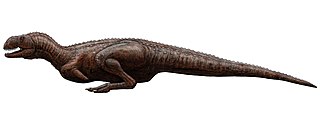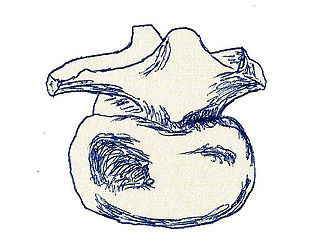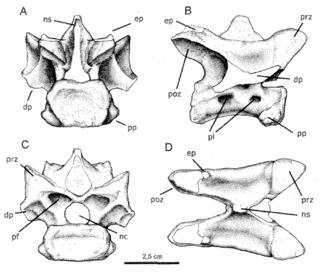
Titanosaurs were a diverse group of sauropod dinosaurs, including genera from all seven continents. The titanosaurs were the last surviving group of long-necked sauropods, with taxa still thriving at the time of the extinction event at the end of the Cretaceous. This group includes some of the largest land animals known to have ever existed, such as Patagotitan—estimated at 37 m (121 ft) long with a weight of 69 tonnes —and the comparably-sized Argentinosaurus and Puertasaurus from the same region.

Titanosaurus is a dubious genus of sauropod dinosaurs, first described by Richard Lydekker in 1877. It is known from the Maastrichtian Lameta Formation of India.

Antarctosaurus is a genus of titanosaurian sauropod dinosaur from the Late Cretaceous Period of what is now South America. The type species, Antarctosaurus wichmannianus, and a second species, Antarctosaurus giganteus, were described by prolific German paleontologist Friedrich von Huene in 1929. Three additional species of Antarctosaurus have been named since then but later studies have considered them dubious or unlikely to pertain to the genus.

Indosuchus is a genus of abelisaurid dinosaur from the Late Cretaceous Period, a theropod related to Abelisaurus. Like most theropods, Indosuchus was a bipedal carnivore. It was about 7 metres long, weighed about 1.2 tonnes, and had a crested skull, flattened on the top.

Argyrosaurus is a genus of titanosaurian sauropod dinosaur that lived about 70 million years ago, during the Late Cretaceous Period of what is now Argentina.

Adamantisaurus is a poorly-known genus of titanosaurian sauropod dinosaur from the Late Cretaceous Period of what is now South America. It is only known from six tail vertebrae but, as a sauropod, it can be assumed that this dinosaur was a very large animal with a long neck and tail.
Jeffrey A. Wilson, also known as JAW, is a paleontologist and professor of geological sciences and assistant curator at the Museum of Paleontology at the University of Michigan.

Indosaurus is a genus of carnivorous theropod dinosaur that lived in what is now India, about 69 to 66 million years ago during the Maastrichtian division of the Late Cretaceous.

Laplatasaurus is a genus of titanosaurian sauropod dinosaur that lived during the Late Cretaceous in South America, with the holotype and only known specimen found in the Anacleto Formation.

Coeluroides is an extinct genus of theropod dinosaur that lived during the Late Cretaceous Period in what is now India. It is based solely on the holotype caudal vertebrae GSI K27/562, K27/574 and K27/595, discovered in a layer of the Lameta Formation. The type species, C. largus, was described by Friedrich von Huene and Charles Alfred Matley in 1933.

Compsosuchus is a dubious genus of abelisauroid dinosaur from the Late Cretaceous Lameta Formation of India.

Isisaurus is a genus of titanosaurian dinosaur from the Late Cretaceous Lameta Formation of India and Pab Formation of Pakistan. The genus contains a single species, Isisaurus colberti.

Dryptosauroides is the name given to a dubious genus of dinosaur from the Late Cretaceous. It was a large theropod, possibly belonging to the Abelisauroidea. It has been estimated as 10 meters long and 1.5 tonnes in weight.

Laevisuchus is a genus of theropod dinosaur from the Late Cretaceous. Its remains were discovered by Charles Alfred Matley near Jabalpur in Maastrichtian "Carnosaur Bed" deposits in the Lameta Formation in Madhya Pradesh, central India, and were named and described by paleontologists Friedrich von Huene and Matley in 1933.

Neuquensaurus is a genus of saltasaurid sauropod dinosaur that lived in the Late Cretaceous, about 80 million years ago in Argentina in South America. Its fossils were recovered from outcrops of the Anacleto Formation around Cinco Saltos, near the Neuquén river from which its name is derived.

The Lameta Formation, also known as the Infratrappean Beds, is a sedimentary geological formation found in Madhya Pradesh, Gujarat, Maharashtra, Telangana, and Andhra Pradesh, India, associated with the Deccan Traps. It is of the Maastrichtian age, and is notable for its dinosaur fossils

Lithostrotia is a clade of derived titanosaur sauropods that lived during the Early Cretaceous and Late Cretaceous. The group was defined by Upchurch et al. in 2004 as the most recent common ancestor of Malawisaurus and Saltasaurus and all the descendants of that ancestor. Lithostrotia is derived from the Ancient Greek lithostros, meaning "inlaid with stones", referring to the fact that many known lithostrotians are preserved with osteoderms. However, osteoderms are not a distinguishing feature of the group, as the two noted by Unchurch et al. include caudal vertebrae with strongly concave front faces (procoely), although the farthest vertebrae are not procoelous.

Sohan Lal Jain is an Indian paleontologist, who worked for 33 years at the Indian Statistical Institute, Kolkata. The large herbivorous sauropod dinosaur genus Jainosaurus, was named in his honour after it was identified as a distinct genus although initially thought to be a species of Antarctosaurus. His other major contributions to paleontology were in the study of sauropod braincases and some fossil turtles.
Pitekunsaurus is a genus of titanosaurian sauropod dinosaur from the Late Cretaceous Anacleto Formation of Neuquén, Argentina. It was described by L. Filippi and A. Garrido in 2008. The type species is P. macayai. The generic name is derived from Mapudungun pitekun, meaning "to discover", the epitheton honours the discoverer, oil company explorer Luis Macaya, who found the fossil in April 2004.

Saltasaurinae is a subfamily of titanosaurian sauropods known from the late Cretaceous period of South America, India and Madagascar.































